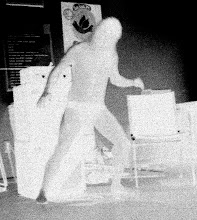Last week I volunteered for the Society of Composers, Inc. national conference here in Santa Fe. I was put off by the attitudes and posturing, in general, of the various 'composers' I came into contact with...and, in specific, by the music that was presented. It was, for the most part, a lousy day full of lousy music. The saving grace was to be able to hang out with my teacher and mentor, David Dunn.
The atmosphere was such that I became, then and there, committed to remaining resolutely and beautifully obscure....firmly in the underground....
The music, for the most part, that was presented was a dead music....much like the most banal of pop musics...recycling the same licks/riffs/trends over and over....an exercise in the lamination of thought. I experienced it as a thesis of what is musically correct and what is musically incorrect....an argument I have no interest in. I have only the interest in engaging music as a complex human phenomenon...one that is either alive or dead. Furthermore I became convinced that a budding thought in my mind...a proposition (that is not new, by any means) that states that music, like any other public human endeavor is rightfully about the freedom of use. I believe in a music that has, at its fundamental core, the belief that all sounds may be used in the composition of a music, regardless of its social or artistic function. I believe this to be true of so-called public space (whether government buildings, streetlights, streets, parks, etc.) as well. If we as a society are not able to determine, for our own pleasures, in what manner a public space is to be used....then it is not a truly public space. If music, as a macrocosmic public endeavor, continues to be governed by a set of near-fascist rules about useage (ie, what notes follow what notes etc. etc.) then it cannot truly be a music. It cannot live. It only exists in the area of the university or academic archive, which is to say, it is neither dead, nor alive....but behaves and is behaved upon as a cryogenic specimen.
Thursday, April 9, 2009
Subscribe to:
Post Comments (Atom)

No comments:
Post a Comment